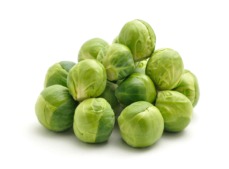Brussels Sprouts

As the name suggests, this member of the brassica family was first grown in the late 16th century in the area of Brussels; then the Princely Capital of The Low Countries, now the capital of Belgium.
Like so many other brassicas it has spread far and wide and is now grown in most temperate regions of the world. Their popularity in Europe gathered momentum after the First World War and the fact that they can easily be frozen and transported has given a further boost in recent years.
Like other brassicas, sprouts contain compounds that can repair damaged DNA and have anti-cancer properties. It is a matter of great interest to the author that, despite a wealth of evidence in favour of a diet that is rich in fresh vegetables, meat and fish, the cancer "industry" still does not see the benefit of prevention, rather than just expensive, invasive treatments. Perhaps that's it; the status quo is patented and just too profitable. For forty years, billions have been spent on cancer research, but the incidence is still on the rise. The only downside of brassicas is that if consumed in excess, they contain goitrogens which can suppress the thyroid gland function by interfering with the uptake of iodine. This rarely affects the human population, but can affect livestock put out to graze on brassica crops and residues.
Sprouts are hardy, slow-growing, long-season vegetables belonging to the cabbage family, traditionally planted in spring and harvested in late autumn and winter. Commercially the seedlings are grown in "modules" containing a peaty growing medium, before being planted out as seedlings. It is essential that all required nutrients are in, or available to the medium, to speed root growth and plant development. Tailored dressings then applied to the field post planting-out will then ensure that the correct balance of nutrients are available through to harvest. Sprouts need a slightly acid pH, moist cool temperatures and respond badly to hot weather.
Field Science has been working with a UK retailer since 2007 to improve the levels of selenium and other trace elements and minerals in various vegetable and salad crops grown in England, Italy, Spain and Portugal. By applying a tailored trace element dressing to the soil in which the Brussels Sprouts are grown, the plant is able to uptake the correct balance of nutrients as and when required, creating a minerally-enriched plant. The improvement is at least 10 times the normal selenium content of normal un-treated sprouts and anecdotal evidence also shows significant improvements in taste.
Field Science has the technology to create tailored mineral dressings to restore the nutrient availability in soils producing healthier, more disease resistant plants with improved yields and a longer shelf life.
The Dressing Process
Field Science tailored mineral dressings are always based on detailed soil analysis of the field to be treated. A member of our technical team will visit your farm to discuss and identify where we can help. Soil samples are then taken and the tailored dressings are based on the independent laboratory’s results.
The Single Crop Dressing is the best option for Brussels Sprouts as the soil is usually ploughed after harvest and that would effectively bury a multi-year dressing out of reach of the roots.
The best time for application is just after emergence or planting-out of module-grown plants. The application rate is usually 25kg per hectare (10kg/ac) and the most effective method of application is to use an electric spinner (slug-pelleter) on a quad bike. The dressings are packed in 25kg bags, clearly labelled with the farm details, field name, application rate and bag weight.
Click Here to read an interesting article about a Field Science customer growing Brussels Sprouts
